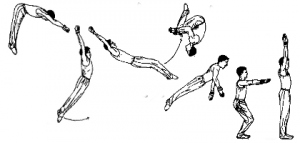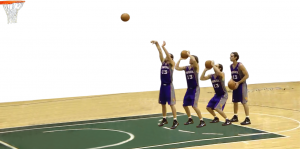What is your question and how did it arise for you?
Inquiry-based learning is becoming the frontier for education within BC. I believe that this student-centered learning is the most beneficial for learners as well as educators, and has the potential to maximize cross-curricular learning if teachers are willing to put in the effort. My inquiry question is as follows: “How can cross-curricular learning be maximized in a Physical Education or Home Economics classroom?” To dig deeper into this question, I will have a series of other questions to ask such as: “In what way(s) do STEM subjects correlate with PE?”, “How are these (STEM) subject inherently applied within the context of PE?”, “Can students recognize these connections within the classroom?” When I was a high school student myself, I had always found benefit in immersing myself in different subjects through different means.
NB: There are varying definitions of STEM and whether it is four separate subjects or four areas that are interwoven. STEM, for the purpose of this paper, refers to Science, Technology, Engineering, and Math as four “separate but related goals” (Bybee, 2013).
Why is your question significant (to you and/or to others)?
This question drives me because I like to be involved in innovation. The thought that this new idea could help benefit student engagement and learner motivation excites me. As a student, I always wondered if there was a practical application of what I was learning, and I think that through physical education and home economics, whereby students get to physically manipulate the world around them, their other subjects have a place to physically manifest the material being taught. Both of these subjects create the ideal classroom to reinforce the STEM subjects for kinesthetic learners.
Because this is a new and emerging field, I think it’s exciting to be looking at possibilities from a new perspective rather than the stale, more traditional pedagogical tactics used previously. This question is important to me because I believe that students will be engaged and excited about their learning if they can understand a practical application of what they are doing outside of the classroom. That is, if students can apply the STEM subjects they are learning in a way that they can see the results physically rather than just on paper, I think that the effectiveness of their learning will be maximized. As a student in high school, I was always involved in many different extra curricular activities, and without really realizing it I was exposed to many different modalities of presenting information I was learning in my classes (Lazear, 2008). For example, when learning about the physics of sound, the set up of the theatre I performed in made more sense to me. I finally realized why the theatre in the round was revolutionary. This also tied into the history of the theatre that also piqued my interest into different historical eras and how theatre, language and culture marked development. Moreover, I had a better understanding of why it was harder to hear in a room like a gymnasium and why we hear things the way we do in a gym versus a classroom versus a theatre.
“The process of teaching and learning STEM offers youth opportunities to make sense of the world they live in and prepare them for the future workforce. High-quality STEM opportunities help youth develop critical thinking, collaboration, and problem solving skills, enhance creativity, and engage in an investigative process.” (The Connectory, 2015)
By investigating this topic in more detail I hope to accomplish a number of things. Over time, I would like to create responsible students who are excited about their learning and who are engaged in other areas of the school consequently (Gray, 2013; Lichtenstein, Ludwig, 2010). I want my students to be able to have meaningful connections with the world around them and to have an appreciation for the real world as much as they do the digital one. Additionally, I hope to legitimize two subjects that are often seen as unnecessary and frivolous but are actually teaching many important life skills in a classroom that is very different than most. By highlighting things like science, math, and social skills taught in Home Ec and PE classrooms I hope to be able to remove stigma. These two areas are often deemed unimportant because they are not academic subjects, but they do cover academic material and are good places for students to take a ‘brain break’ while still learning practical applications of their learning.
What do you expect to find out?
I expect that this inclusion of cross-curricular learning will engage students in their learning and get them excited to understand complex ideas better. My hope is that implementing this style of learning will increase student participation and engagement in these two elective subjects. I also expect that implementing this will be a huge project, and might take my entire career as a teacher to do. Additionally, I expect that the effect it will have on student understanding is worth putting in the time and effort.
How will your Inquiry ‘look’ during your practicum?
For my practicum, I hope to incorporate some STEM material into my lessons in as many ways as possible. If it is at all possible, I plan to talk to other teachers to learn about some of the curricula that they are covering during the time I am teaching. Armed with this knowledge, I hope to begin to incorporate STEM slowly into warm ups, drills/explanations, and during the student practices.
To put this idea into motion will require some planning and working with other departments, but can also be done at a lower level more immediately. In warm ups or demonstrations, the scientific or mathematical principle of what is happening can be discussed. An example of this is in a Foods classroom where students will be baking. The steps to follow for baking resemble the steps followed in a chemistry lab because baking is a portion of the chemistry of food sciences (Vohs, 2013).
Resources:
In recent years, there has been research into to the benefits of cross-curricular learning. For my inquiry, I will be referencing websites designed by EdTech, Edutopia, Connect A Million Minds, and STEM Education Awareness, all listed below.
http://www.edutopia.org/blog/stem-engagement-maker-movement-annmarie-thomas
http://www.connectamillionminds.com/videos.php#all
http://www.ccedtech.com/2014/02/integrating-stem-with-physical-education.html#.Vk4bkt-rRE7
http://www.stemeducationawareness.ca/young-minds
Additionally, I will be referencing articles from journals such as the Journal of STEM Education, Journal of Biomechanics, and Advances in Physical Education.
Listed below in the references section of this paper are some supplementary sources that I will use during the inquiry process.
The new curriculum being released soon is riddled with integration between subjects. The “big ideas” that are being presented can be approached in so many different ways, and it would be a disservice to students to not present the material in a way that is being cited as some of the most innovative and engaging learning available. In academia I have found it difficult to find research specifically supporting STEM subjects in physical activity and education because at that level, the science of movement is inherently already seen as a science, using math, technology, and engineering to further develop the field.
What if any, are your limitations of this study?
Working with other departments could prove to be more difficult than I am anticipating. Factoring this in, an individual teacher in the class can still ask this question, but the results would not be as comprehensive as I would like. It would be ideal to see this material repeated in multiple classes, and presented by multiple teachers, but it is still possible to integrate multiple disciplines into one class as an individual teacher. Additionally, planning with teachers may not go as well as I imagine it to. Other teachers may not be interested in the idea, or might simply see it as too much additional work and planning. As well, in order for this to happen, the timetable of students needs to line up. That is, if I am teaching a grade 10 class and I wanted to pair with a Science 10 class, they would need to happen in the same block.



